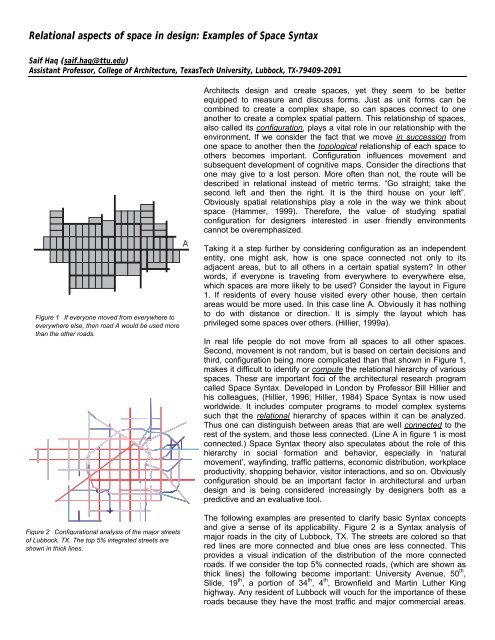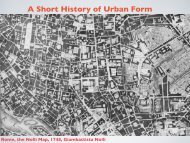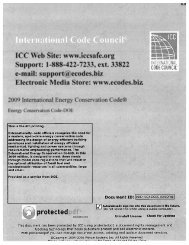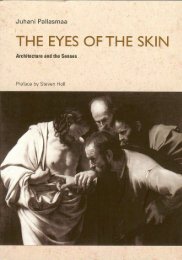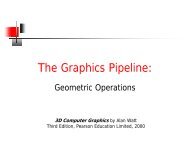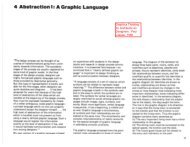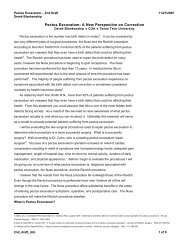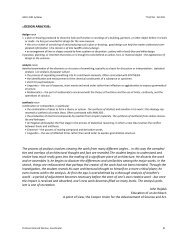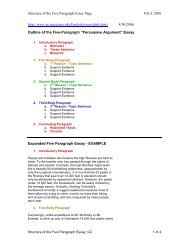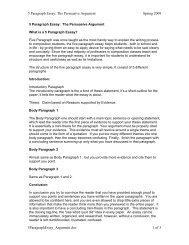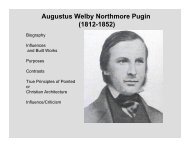Relational aspects of space in design
Relational aspects of space in design
Relational aspects of space in design
You also want an ePaper? Increase the reach of your titles
YUMPU automatically turns print PDFs into web optimized ePapers that Google loves.
<strong>Relational</strong> <strong>aspects</strong> <strong>of</strong> <strong>space</strong> <strong>in</strong> <strong>design</strong>: Examples <strong>of</strong> Space SyntaxSaif Haq (saif.haq@ttu.edu)Assistant Pr<strong>of</strong>essor, College <strong>of</strong> Architecture, TexasTech University, Lubbock, TX-79409-2091Figure 1 If everyone moved from everywhere toeverywhere else, then road A would be used morethan the other roads.Figure 2 Configurational analysis <strong>of</strong> the major streets<strong>of</strong> Lubbock, TX. The top 5% <strong>in</strong>tegrated streets areshown <strong>in</strong> thick l<strong>in</strong>es.AArchitects <strong>design</strong> and create <strong>space</strong>s, yet they seem to be betterequipped to measure and discuss forms. Just as unit forms can becomb<strong>in</strong>ed to create a complex shape, so can <strong>space</strong>s connect to oneanother to create a complex spatial pattern. This relationship <strong>of</strong> <strong>space</strong>s,also called its configuration, plays a vital role <strong>in</strong> our relationship with theenvironment. If we consider the fact that we move <strong>in</strong> succession fromone <strong>space</strong> to another then the topological relationship <strong>of</strong> each <strong>space</strong> toothers becomes important. Configuration <strong>in</strong>fluences movement andsubsequent development <strong>of</strong> cognitive maps. Consider the directions thatone may give to a lost person. More <strong>of</strong>ten than not, the route will bedescribed <strong>in</strong> relational <strong>in</strong>stead <strong>of</strong> metric terms. “Go straight; take thesecond left and then the right. It is the third house on your left”.Obviously spatial relationships play a role <strong>in</strong> the way we th<strong>in</strong>k about<strong>space</strong> (Hammer, 1999). Therefore, the value <strong>of</strong> study<strong>in</strong>g spatialconfiguration for <strong>design</strong>ers <strong>in</strong>terested <strong>in</strong> user friendly environmentscannot be overemphasized.Tak<strong>in</strong>g it a step further by consider<strong>in</strong>g configuration as an <strong>in</strong>dependententity, one might ask, how is one <strong>space</strong> connected not only to itsadjacent areas, but to all others <strong>in</strong> a certa<strong>in</strong> spatial system? In otherwords, if everyone is travel<strong>in</strong>g from everywhere to everywhere else,which <strong>space</strong>s are more likely to be used? Consider the layout <strong>in</strong> Figure1. If residents <strong>of</strong> every house visited every other house, then certa<strong>in</strong>areas would be more used. In this case l<strong>in</strong>e A. Obviously it has noth<strong>in</strong>gto do with distance or direction. It is simply the layout which hasprivileged some <strong>space</strong>s over others. (Hillier, 1999a).In real life people do not move from all <strong>space</strong>s to all other <strong>space</strong>s.Second, movement is not random, but is based on certa<strong>in</strong> decisions andthird, configuration be<strong>in</strong>g more complicated than that shown <strong>in</strong> Figure 1,makes it difficult to identify or compute the relational hierarchy <strong>of</strong> various<strong>space</strong>s. These are important foci <strong>of</strong> the architectural research programcalled Space Syntax. Developed <strong>in</strong> London by Pr<strong>of</strong>essor Bill Hillier andhis colleagues, (Hillier, 1996; Hillier, 1984) Space Syntax is now usedworldwide. It <strong>in</strong>cludes computer programs to model complex systemssuch that the relational hierarchy <strong>of</strong> <strong>space</strong>s with<strong>in</strong> it can be analyzed.Thus one can dist<strong>in</strong>guish between areas that are well connected to therest <strong>of</strong> the system, and those less connected. (L<strong>in</strong>e A <strong>in</strong> figure 1 is mostconnected.) Space Syntax theory also speculates about the role <strong>of</strong> thishierarchy <strong>in</strong> social formation and behavior, especially <strong>in</strong> ‘naturalmovement’, wayf<strong>in</strong>d<strong>in</strong>g, traffic patterns, economic distribution, workplaceproductivity, shopp<strong>in</strong>g behavior, visitor <strong>in</strong>teractions, and so on. Obviouslyconfiguration should be an important factor <strong>in</strong> architectural and urban<strong>design</strong> and is be<strong>in</strong>g considered <strong>in</strong>creas<strong>in</strong>gly by <strong>design</strong>ers both as apredictive and an evaluative tool.The follow<strong>in</strong>g examples are presented to clarify basic Syntax conceptsand give a sense <strong>of</strong> its applicability. Figure 2 is a Syntax analysis <strong>of</strong>major roads <strong>in</strong> the city <strong>of</strong> Lubbock, TX. The streets are colored so thatred l<strong>in</strong>es are more connected and blue ones are less connected. Thisprovides a visual <strong>in</strong>dication <strong>of</strong> the distribution <strong>of</strong> the more connectedroads. If we consider the top 5% connected roads, (which are shown asthick l<strong>in</strong>es) the follow<strong>in</strong>g become important: University Avenue, 50 th ,Slide, 19 th , a portion <strong>of</strong> 34 th , 4 th , Brownfield and Mart<strong>in</strong> Luther K<strong>in</strong>ghighway. Any resident <strong>of</strong> Lubbock will vouch for the importance <strong>of</strong> theseroads because they have the most traffic and major commercial areas.
.7.6All_people/ft..5.4.3.2.101.5 2 2.5 3 3.5 4 4.5 5 5.5 6RRA3rightw ithoutrdY = -.14 + .087 * X; R^2 = .423Figure 3 Scatergram shows the relationship <strong>of</strong> thepresence <strong>of</strong> people <strong>in</strong> TexasTech campus with theirSyntax values.The configurational structure revealed by computer analysis is basedonly on how each road is connected to others and not on any otherfactor; yet it has closely resembled the exist<strong>in</strong>g situation 1 .The second example is <strong>of</strong> the TexasTech campus. An ongo<strong>in</strong>g study <strong>of</strong>pedestrian behavior and configurational analysis <strong>of</strong> the exist<strong>in</strong>g paths<strong>in</strong>dicate that presence <strong>of</strong> people <strong>in</strong> any path is a function <strong>of</strong> its syntaxvalue 2 i.e. more connected <strong>space</strong>s will have more people <strong>in</strong> them(r=.650, p=.0006, see figure 3 and 4). This is another example <strong>of</strong> theapplied value <strong>of</strong> syntactic studies. Figure 5 shows the work undertakenby graduate students 3 as part <strong>of</strong> Arch 5362, Theory <strong>in</strong> Architecture.Work<strong>in</strong>g with data from a small sample regard<strong>in</strong>g ‘imagability’ <strong>of</strong> thecampus, (Lynch, 1960) the students proposed appropriate paths (shown<strong>in</strong> red) <strong>in</strong> the campus. If this is compared with the master plan <strong>design</strong>edby HOK and partners (Figure 6) we see a remarkable similarity.Additionally, syntactic analysis <strong>of</strong> the master plan confirms that the newpaths will be the most connected areas <strong>in</strong> campus and therefore may beexpected to be most crowded. It is <strong>in</strong>terest<strong>in</strong>g to note that the common<strong>aspects</strong> <strong>of</strong> both research on students ‘image <strong>of</strong> the campus’ and anarchitect’s <strong>in</strong>tuition are be<strong>in</strong>g matched by computational outcomes. Onecan therefore extend these ideas and beg<strong>in</strong> to understand the usefulness<strong>of</strong> Space Syntax as a <strong>design</strong> tool.Figure 4 Space Syntax analysis <strong>of</strong> the pathways <strong>in</strong>TexasTech campus.Figure 5 Student proposal for new pedestrian paths(shown <strong>in</strong> red) <strong>in</strong> TexasTech campus. This is based on astudy <strong>of</strong>’ imagibility’ <strong>of</strong> the campus.Syntax results <strong>in</strong> Lubbock, TX are not isolated. They follow a patternseen <strong>in</strong> numerous research literatures where configuration has beenfound to be <strong>in</strong>dicative <strong>of</strong> various patterns. For example, Alan Penn(2001) <strong>in</strong>forms us that about 60 to 80% <strong>of</strong> variation <strong>in</strong> movement ratesfrom location to location, <strong>in</strong> areas where land uses and developmentdensities are relatively homogenously distributed can be accounted forby measures <strong>of</strong> spatial configuration alone. This is based on plentifulstudies <strong>in</strong> various cultures distributed globally. The author himself hasstudied the role <strong>of</strong> configuration <strong>in</strong> the case <strong>of</strong> wayf<strong>in</strong>d<strong>in</strong>g <strong>in</strong> three largeUS hospitals and has concluded that configurational properties <strong>of</strong> <strong>space</strong>sand their use dur<strong>in</strong>g wayf<strong>in</strong>d<strong>in</strong>g are correlated strongly (average r=.60).Additionally <strong>space</strong>s <strong>of</strong> higher values also feature <strong>in</strong> the cognitive maps(average=.68) and that syntactic properties <strong>of</strong> entry po<strong>in</strong>ts <strong>in</strong>fluencewayf<strong>in</strong>d<strong>in</strong>g success. (Haq, 1999) It has been shown that relationalproperties are also important factors <strong>in</strong> crime distribution and prevention(see Hillier, 1999 for British examples and Fanek, 1997 for studies <strong>in</strong>Aust<strong>in</strong>, TX) and to some degree features <strong>in</strong> the success or failures <strong>of</strong>shopp<strong>in</strong>g areas. (Brown, 1994) Also, Syntax methods have been quiteuseful <strong>in</strong> archeological explorations. (Ferguson, 1996)The most pervasive argument <strong>of</strong> Space Syntax is that configuration<strong>in</strong>fluences location characteristics and this impacts our understand<strong>in</strong>gand use <strong>of</strong> <strong>space</strong>s. It also provides computer programs to modelconfigurational values. Recently, Space Syntax has moved to thepr<strong>of</strong>essional realm where its computational methods are called upon toanalyze exist<strong>in</strong>g conditions and to <strong>in</strong>vestigate <strong>design</strong> proposals. Theyhave proved to be extremely useful <strong>in</strong> <strong>design</strong> decision mak<strong>in</strong>g. SpaceSyntax br<strong>in</strong>gs rigor to the <strong>design</strong> process specifically those <strong>in</strong>volv<strong>in</strong>gcomplex build<strong>in</strong>gs, community development and urban <strong>design</strong>.1 A full fledged analysis <strong>of</strong> Lubbock city is presently be<strong>in</strong>g undertaken by the author at TexasTech University.2 A larger study <strong>of</strong> TexasTech Campus is also <strong>in</strong> progress.3 Alicia Jones, Eden Liv<strong>in</strong>gstone and Just<strong>in</strong> Noble, Fall 2001
Figure 6 Computer based Syntactic analysis <strong>of</strong>proposed master plan <strong>of</strong> TexasTech University campusby HOK and partners.Brown, M. G. (1994, Sept). Autopsy <strong>of</strong> a Shopp<strong>in</strong>g Center. Urban Land, 32-37.Fanek, M. F. (1997). The use <strong>of</strong> Space Syntax methodology <strong>in</strong> predict<strong>in</strong>g thedistribution <strong>of</strong> crime <strong>in</strong> urban environments. Unpublished Doctoraldissertation, TexasTech University, Lubbock.Ferguson, T.J. (1996) Historic Zuni Architecture and Society An archeologicalApplication <strong>of</strong> Space Syntax, Tucson: The University <strong>of</strong> Arizona PressHammer, M. (1999). Well Connected, [journal electronic publication]. Available:www.newscientist.com/ns/19991113/wellconnec.html [1999, November15].Haq, S. (1999). Can Space Syntax Predict Environmental Cognition.Proceed<strong>in</strong>gs <strong>of</strong> the Space Syntax Second International Symposium,Brasilia, Brazil.Hillier, B. (1999a). The hidden geometry <strong>of</strong> deformed grids: or, why <strong>space</strong> syntaxworks, when it looks as though it should'nt. Environment and Plann<strong>in</strong>g B,26, 169-191Hillier, B.(1999) Do Burglers understand Defensible Space. Available:http://www.<strong>space</strong>syntax.com/hous<strong>in</strong>g/BillCrimePaper/BillCrimePaper.html [2002, 15 Aug, 2002].Hillier, B. (1996). Space is the Mach<strong>in</strong>e. Cambridge: Cambridge University Press.Hillier, B. H., Julienne. (1984). The Social Logic <strong>of</strong> Space (Paperback Edition1988 ed.). Cambridge: Cambridge University Press.Lynch, K. (1960). The Image <strong>of</strong> the City. Cambridge: Jo<strong>in</strong>t Center for UrbanStudies.Penn, A. (2001). Space Syntax and Spatial Cognition Or, why the axial l<strong>in</strong>e.Proceed<strong>in</strong>gs <strong>of</strong> the Space Syntax 3rd International Symposium,GeorgiaTech, Atlanta.


